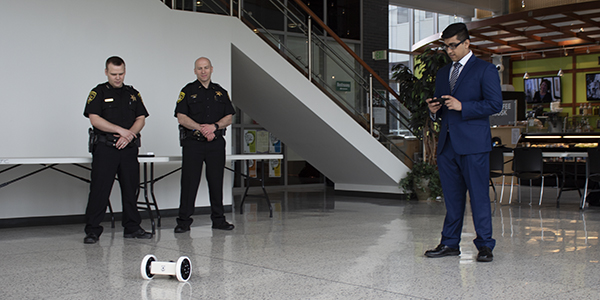Watson seniors design reconnaissance robot for police work
Senior design project to be utilized by Tioga County Sheriff's Department

Seniors in the Thomas J. Watson School of Engineering and Applied Science presented their capstone projects to fellow students, faculty advisors and their sponsors on the final day of classes Friday, May 10.
Teams of students used PowerPoint and hands-on demonstrations to showcase what they worked on, and one project in particular caught some media attention – the Reconnaissance Robot developed for the Tioga County Sheriff’s Department.
The project came about when Roy McGrann, one of the faculty advisors on the project, and Tom Gallagher, a Tioga County Sheriff’s deputy, met at the wedding reception of a mutual friend of their wives. Gallagher was interested in developing a robot to aid the Tioga County Sheriff’s SWAT team during building-clearing operations, such as he had used when an Army Ranger, but at a much lower cost than the military device. It was decided to pursue this as a capstone project.
Kaiyan Yu, assistant professor of mechanical engineering, was brought into the project as a robotics specialist and five students and their roles were assigned:
from mechanical engineering: Christopher Gale, Daniel Adamczuk, and John McCoy worked on the structure and drive components
from computer engineering: Avishek Paul worked on the Android app and communications
from electrical engineering: Joseph Squitieri worked on power and controls
The requirements for the robot were determined through a series of meetings of the students, advisors and representative of the Tioga County Sheriff’s Department.
“We were tasked with the design and fabrication of a robot to assist in keeping officers safe during high-risk situations and to allow them to see before entering a room or area,” Adamczuk said. “It’s not to be used every day, but in high-risk situations like when a SWAT team is called in.”
There were several key requirements the team had to meet when designing the robot. It needed to weigh less than 10 pounds, be able to fit into a 1 cubic-foot space of a satchel, have a replacement cost of no more than $1,000, and include complete operating and repair manuals.
Gale explained the overall design, noting that the brain of the robot is actually a Raspberry Pi computer that sees using a Raspberry Pi NoIR camera. The camera picture is sent as a stream to the user’s Android device (phone or tablet). “The whole thing is controlled with an Android app,” Gale said. “It’s definitely strong and will hold up. There are two structural shell components including a housing and cap to hold everything in place.”
“We also ran the robot for 21 minutes and shut it off to check the heat level,” Squitieri said. “It’s rated for 150 degrees Celsius. It cools down five times faster than it heats up.”
The robot weighs 5.2 pounds, its maximum speed is 1 meter per second, and the speed, as well as direction, can be controlled through the app.
“We can connect it to a wireless router to create a local network through which we can transfer data,” Paul said. “The app itself has several options. We can set both the forward and reverse speeds of the motors for your preference and the circumstances of the use. Once you’re ready to start the stream, you hit a button and can see the actual video stream. There’s also a light button and a camera flip button in case the robot is turned over.”
The robot includes 33 separate parts — 30 are standard parts that can be bought online so they’re easily replaced. The shell (housing and cap) are 3D-printed ABS+ and can be reprinted using the manufacturing files the students created. The aluminum wheel connector can be machined using the students’ drawings.
Total cost of the robot from start to finish was less than the students’ original estimate of $925, said McCoy. The final product came in at $721, well under the $1,000 maximum cost requirement.
The presentation ended with a demonstration of the robot, which showed its 360 degree movement and speed adjustments from pushing buttons on a set-up screen, and video stream updates in real time on an Android phone. Following the demonstration, the robot, along with operations and repair manuals, were given to the Tioga County Sheriff Gary W. Howard.

